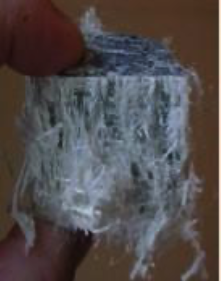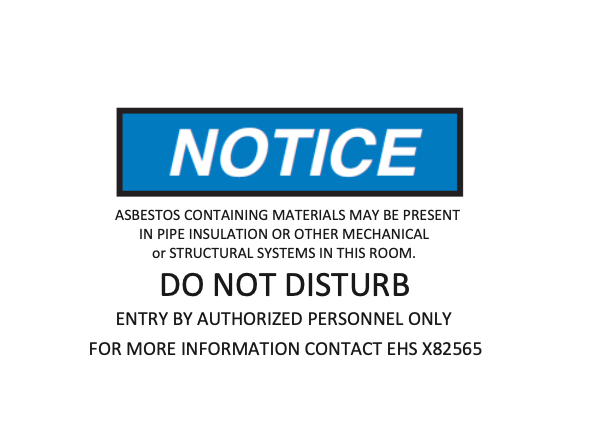Purpose
The purpose of this program is to minimize exposure to airborne asbestos fibers.
Program Elements
Asbestos comprises a set of six a naturally-occurring silicate minerals with the similar physical structure of forming long, thin, fibrous crystals.
Asbestos has been mined for thousands of years, but increased dramatically in the 19th century when manufacturers used asbestos for its desirable physical properties including sound absorption, resistance to heat, fire and chemical damage and its affordability.
It has been widely used in electrical insulation, building insulation and materials, brake linings and many other applications where it is mixed in with cement or woven into fabrics or other materials.

All forms of asbestos are known human lung carcinogens when a person is excessively exposed to the loose fibers or asbestos dust. Loose fibers or dust can become airborne and cause exposures in the occupational setting.
Known cases of asbestosis (a lung disease) and mesothelioma (a specific lung cancer only caused by asbestos) occurred in manufacturing industries in the early 20th century where asbestos was used extensively, such as ship building, or insulation manufacturing.
Because of its health impacts, the US banned asbestos in 1978. Today, health effects are very rare because asbestos exposure is tightly controlled and managed. In the U.S., asbestos exposure today mainly occurs when people repair or demolish old materials that contained asbestos. When such work is done, it is tightly controlled and strict rules for exposure control and safety must be followed.
While the US banned the manufacture and use of asbestos in 1978, many of the buildings and structures built around and before 1978 still contain asbestos in various building materials, such as:
- Acoustical (Popcorn) Ceiling Material
- Transite Flue Pipes
- Thermal Systems Insulation (TSI)
- Floor Tile and Adhesive
- Fire Doors
- Fire Proofing
- Sheet Flooring Products
- Gypsum Wallboard Joint Compound or Texturing Materials
- Roofing Materials
- Exterior Stucco or siding
- Transite panels & pipes
Capital Planning, Design & Construction, (CPDC), maintains the records of the history of asbestos surveys and remediation activities as part of their asbestos operations and maintenance (O & M) program.
Each year they provide the EH&S department with an updated a list of locations at SFSU that are known to have asbestos containing building materials.
EH&S then provides the list to all employees as an email from CSU-Learn as part of compliance with the Connelly Act (AB 3713) which calls for annual notification to employees.
Current Asbestos Notification Memo
The University provides this information to employees each year via email or CSU Learn assignment.
EH&S provides annual asbestos awareness training to Facilities’ employees so that they can identify suspected asbestos containing building materials
Objective:
To clarify the role of SFSU union employees in dealing with potential asbestos containing materials and lead paint coated materials
Statement:
Only employees who are properly trained and authorized by EHS may sample or otherwise disturb materials that are expected to contain asbestos or lead based paint.
Procedures:
1. Employees who come upon materials that they suspect may contain asbestos or lead paint shall not disturb the material in any way.
2. They are to contact EHS.
3. EHS will arrange for sampling and signage as needed.
4. If the material does contain lead or asbestos, that information will be forwarded to Capital Planning.
5. Capital Planning will record the location of the material, and if necessary will address/remediate the situation.
Following the procedures defined in EH&S’ “Asbestos, Mold, or Lead Paint Remediation – Hazardous Work Permit” CPDC or Facilities will hire a licensed asbestos abatement contractor to conduct the remediation.
The work area will be isolated with plastic sheeting and kept at negative pressure relative to outside of the work area to contain any asbestos fibers. Air exhausted from the work area goes through HEPA filters to protect the outside environment.
A third party contractor is hired to monitor the air inside and outside the work area throughout the project to ensure that these precautions are effective. Disposal of asbestos containing waste material is conducted by licensed hazardous waste disposal contractors managed by the EH&S department.

BAAQMD Control Measures For Construction And Grading
